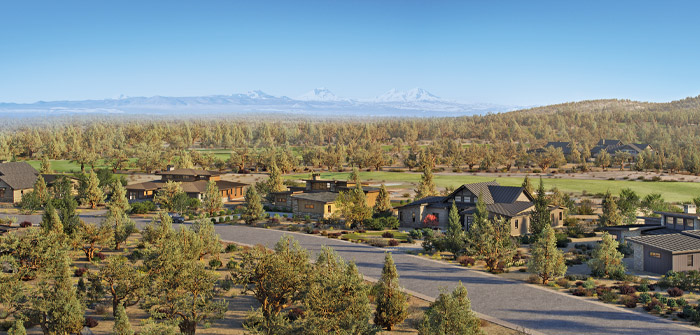(Rendering | courtesy of Thornburgh Resort)
Weighing the Pros & Cons of a New Luxury Resort
North of Tumalo down Cline Falls Highway, 1,960 acres of land are set to be turned into the region’s newest resort community, fit with world-class golf, luxury homes and artificial lakes. The development has seen pushback over the years from a variety of sources and community members, with tensions reaching a high point this last spring when the environmental watchdog organization, Central Oregon LandWatch, took up a campaign on social media to raise awareness on the proposed sale of 400 more acres of public land to the resort’s developers.
The sale never went through, and the resort will remain on the original 1,960 acres of land. Despite this news, many of the same concerned community members are still arguing against the existence of the resort, while others are looking forward to the potential economic impact this luxury development will have on the nearby city of Redmond.
The history of the property stretches back to the early 20th century when it was owned by Jack Shumway. “My grandfather was at the Deschutes County Fair in 1953 talking to Shumway and asked him if he had ever thought about selling that Cline Butte property,” said Thornburgh Developer Kameron DeLashmutt. “Shumway said, ‘I hadn’t thought about selling it, but it sounds like you’ve thought about buying it.’”
The property was sold to DeLashmutt’s family for $5,000 and 35 yearling heifers, and plans for the resort began sprouting in the early 2000s. In 2005, the developers submitted their first land use application.
Now, the development is moving forward with at least one golf course, 950 luxury homes, multiple lakes and many of the classic fixtures found at other resort communities like a clubhouse and a community hall, along with dining, fitness and spa buildings.
The environmental impact of the resort is the foremost issue on the mind of most critics. In response, DeLashmutt has taken steps to mitigate the impact on the nearby landscape and neighboring communities. “We like to put a big emphasis on natural elegance,” he said.
The Deschutes County Code dictates many factors for new developments, including the density at which they are being built. The DCC in this case allows 1.5 homes per acre of land, and Thornburgh falls far under that limit by building an average of .48 homes per acre of land. The DCC dictates that at least 50 percent of the development must be open space. Thornburgh will have 66 percent of their property be open space, with the majority dedicated to preserving native landscaping; nearly 900 acres will remain almost entirely untouched and preserved.
The golf course currently being developed is designed by some of the top architects in the world, the Whitman, Axland and Cutten group. The course has been designed to mitigate the impact on the natural environment, with plenty of old-growth juniper trees being marked off for preservation, including one that the team has nicknamed “Big Red.”
Compared to other courses across the region and the nation, this course will have a relatively low impact on the environment that surrounds it, keeping with the resort’s theme of natural elegance.
“We like to imagine, instead of changing the land, we’re just dropping a sheet right on top,” Axland said. “The goal is to let the landscape guide us, as opposed to competing with nature. If anything, we just want to compliment the natural surroundings and preserve the natural history of this land.” Fit with water-efficient species of turf and features made to compliment the views of the Three Sisters, this course aims to showcase the natural beauty of the land while helping maintain it.
Still, there is one key issue that causes massive amounts of concern in neighboring communities: water. Water has been the single most significant environmental factor in arguments against Thornburgh, and it will likely stay that way.
Acknowledging that the region is experiencing a drought, DeLashmutt has taken steps to decrease how much water the resort will need. A newly proposed permit would allocate the resort 1,460 acre feet of water for a maximum daily pumping of about 1.3 million gallons. As far as consumptive use goes, the resort will require less than 800,000 gallons per day, far below the original 6 million gallon estimate that was widely shared on social media.
Still, opponents say that any amount of increased water use is too much. While Thornburgh has taken steps to become a more environmentally friendly development, the Executive Director of LandWatch Ben Gordon says that this statement is an oxymoron, “the development of luxury homes, golf courses and manmade lakes in a rural area that lacks the adequate infrastructure, cannot be environmentally friendly,” Gordon said.
LandWatch has been keeping an eye on this development for years now, and is opposed due to water usage and the potential loss of public land around Cline Butte. “Farmers, ranchers, hunters, mountain bikers and more have all spoken up with different concerns over this development,” Gordon said. “The community has spoken.”
Gordon is referring to a community letter, signed by over 4,500 hundred interest groups, small businesses and individuals who represent thousands more across the region, who all oppose the resort’s development and the proposed purchasing of 400 acres of public land. While many different groups had a stake in the conversation, no one was quite as concerned as local farmers and rural citizens who are seeing their wells run dry. “People who thought their well would last are now sputtering dry,” Gordon said. “Add any straw to that ground, and the issue will grow.”
Gordon added that “A water thirsty development on rural ground during a drought, is not something we can fully support. It just doesn’t make sense to see that development in that location at this time.”
This message is echoed by local farmer Cate Havstad-Casad. Co-owner of Casad Family Farms just outside of Madras, Havstad-Casad said that as long as farmers and ranchers are in situations this dire, this development will be detrimental to the community.
“Our farm has lost 80 percent of the water we typically need to sustain ourselves, and plenty of other farmers are facing the same thing, along with more and more wells going dry, as well,” she said. “At this point in time, Central Oregon is already an over tapped water resource. Any water he takes, he is taking from an over tapped resource. Until landowners’ wells are not going dry and farmers are not going bankrupt due to not having enough water to farm, there is not enough water for his luxury resort.”
Havstad-Casad followed up by saying, “When a development has been contested by thousands of community members over the last 18 years, the community has spoken clearly. They do not want this resort, because it will not support the community.”
While the resort objectively has a toll on the environment, DeLashmutt has also been vocal about how the development will impact the local community. For example, yearly tax revenue from the resort will pump an estimate of over $10 million into the Redmond public school system, over $3 million into rural fire protection and nearly $1 million for the county library.
On the water side of things, DeLashmutt has offered to donate a one-time supply of 200 acre feet of water that would go unused, otherwise, to the North Unit Irrigation District where many farmers and ranchers are struggling. While the donation is appreciated from the standpoint that any amount of water is appreciated, some local farmers have voiced their concern over the amount of water received, and the timing of the donation.
Once that donation is divided between each farm and household, the donation comes out to about .002-.004 acre feet of water, which equates to about 650-1,300 gallons. The donation, while claimed to be in good faith by the developers, has been criticized for being far too small to have a real impact on a farming operation, with some critics arguing that the donation exists solely to help with the resort’s public image, speculating that the donation was done to help the resort’s groundwater permit get approval from the Oregon Water Resource Department.
“Either the Oregon Water Resource Department is doing their job in protecting our resources, or not,” Havstad-Casad said. “It is that simple.”
While the Thornburgh development has taken large steps compared to other resorts to become environmentally friendly and show how the resort will positively affect the community of Redmond, opponents of the resort argue that the mere existence of the development at this point in time is not beneficial and does not make sense. As long as farmers are struggling like they are now, it is unlikely that concerns over water will be going anywhere.





